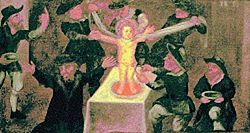Harold of Gloucester facts for kids
Quick facts for kids SaintHarold |
|
|---|---|

blood libel image of child sacrifice
|
|
| Martyr | |
| Born | Aroldo |
| Died | 17 March 1168 Gloucester, England |
| Venerated in | Roman Catholic Church |
| Major shrine | Gloucester |
| Feast | 25 March |
Harold of Gloucester was a young boy who died in 1168. Some Benedictine monks in Gloucester, England, falsely claimed he was a "child martyr." They spread a story that he had been murdered by Jews. These claims were part of a harmful lie called the blood libel. This lie suggested that Jewish people ritually killed Christian children. The story about Harold came after similar false claims about William of Norwich. For a short time, people in Gloucester honored Harold as a saint, but this practice soon stopped.
Contents
Understanding the Story of Harold
Harold is one of several unofficial "saints" from 12th-century England. These were all young boys who were found dead under mysterious circumstances. In each case, people falsely claimed they were martyrs. A martyr is someone who dies for their beliefs. These claims were made because of supposed anti-Christian actions by Jews. The false ideas about how these boys died led to the harmful myth known as the blood libel.
Other Similar False Claims
The accusations about Harold's death happened after widely spread false stories. These stories claimed that Jewish people ritually murdered children. The most famous early case was William of Norwich, who died in 1144. After Harold's story, similar false claims were made about Robert of Bury. This pattern of false accusations continued. It reached a peak with the trials and executions that followed the death of Hugh of Lincoln.
Harold's Death and False Accusations
Harold's body was found floating in a river. Local Benedictine monks used this discovery to spread a false story. They claimed that "the child had been taken by the Jews." They said this happened on February 21st, and that he was tortured to death on the night of March 16th. The monks also pointed to marks on his body. They claimed these marks suggested he had worn a crown of thorns. They also said he had been subjected to some form of crucifixion. These details were very similar to the false stories made up about William of Norwich in 1144.
Why the Story Spread
The story gained some false belief because Jewish people had gathered in Gloucester at that time. They were there for a brit milah ceremony. This is a Jewish circumcision ritual. In the minds of some Christians, the symbolic spilling of a child's blood in circumcision was wrongly linked to the Christian story of the Crucifixion. The events seemed to happen close to Easter. However, there are different dates given in old records. This suggests there might have been confusion about the exact year. It also hints that people might have tried to force the dates to fit Christian holidays.
There is no proof that any Jewish people were ever arrested or charged with a crime. This suggests the claims started as mere guesses after the boy's body was found. The false accusation did, however, lead to Gloucester Jews lending money. This money helped finance Richard de Clare, also known as "Strongbow." He used the money for his conquest of Ireland.
The Cult of Harold
Over time, this false story became accepted as fact in later retellings. However, the attempt to create a "cult" around Harold was not successful. A cult in this sense means a group of people who worship or honor someone. This honor for Harold was never officially supported by the church. It died out long before the Reformation, a major change in the Christian church.
Why Harold's Story Was Important
Historian Joe Hillaby says that the story of Harold was not widely known. It was much less famous than the story of William of Norwich. However, it was very important. It showed that the false stories created about William's death could be used again. These stories became a pattern for explaining other deaths. For the first time, an unexplained child's death near the Easter festival was wrongly linked to Jewish people nearby. This was done by local Christian church leaders. Hillaby notes that "they established a pattern quickly taken up elsewhere. Within three years the first ritual murder charge was made in France."
See also
See also the articles of other children whose deaths in medieval times gave rise to the persecution of the Jews:
- Andreas Oxner
- Gabriel of Belostok
- Little Saint Hugh of Lincoln
- Robert of Bury
- Simon of Trent
- Werner of Oberwesel
- William of Norwich

